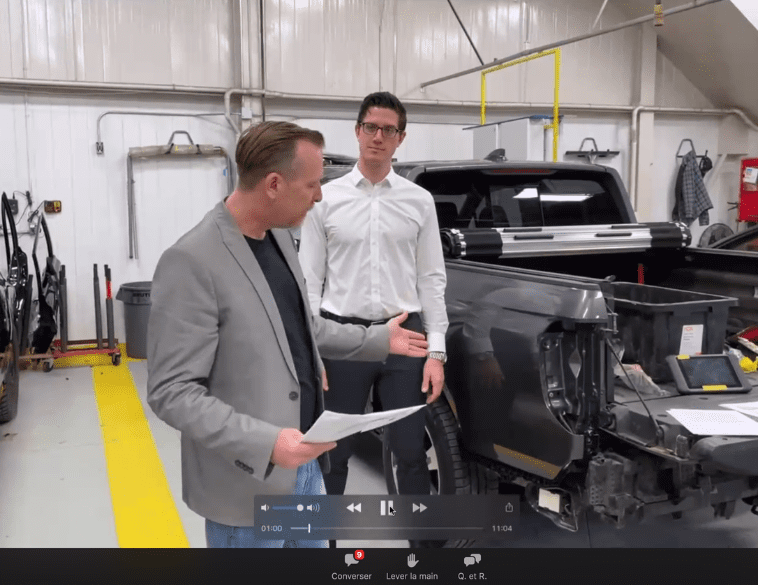Advanced Driver Assistance Systems (ADAS) are part and parcel of most late-model vehicles. For collision repairers, this means that every vehicle that rolls into the shop must have a detailed repair plan before any type of work begins.
Whether the hit on a vehicle is big or small, ADAS calibrations come into play on most newer vehicles. To help understand what’s involved in performing these calibrations properly, CCIF hosted a webinar entitled Strategic Repair Planning for Diagnostics and ADAS.
Moderated by Patrice Marcil, Customer Experience Director, North America, Axalta Coating Systems and featuring Nick Dominato, Senior Vice President, asTech Automotive and David Friars, Director of Operations, Drive Autogroup, Collision Centres, the virtual session looked at three different vehicles with three different types of damage and assessed what was required in the repair plan and how the work needed to be performed in order to return the vehicle to fully-functioning, pre-collision condition.
Minor crack
The first example was a 2019 Honda Ridgeline that required what seemed a minor repair. The vehicle had a small crack on the driver’s side of the rear bumper cover, requiring replacement of the bumper cover with a new, OEM item. Yet as with many smaller repairs, there was more to this than just replacing a cracked bumper cover. A small repair was also required on the rear of the box where it meets the bumper cover and there was also a blind spot sensor located very close to the repair area.
According to information from Honda at the time this repair was performed, a wheel alignment was required in addition to recalibrating the blind spot sensor.
Nick Dominato mentioned that often in cases like this when the vehicle comes into the shop and pre-scan is performed, the calibration requirement won’t show up on the scan. Therefore, technicians need to look at actual service information from Honda to determine what is required.
“After the wheel alignment, we are going to have to perform a blind spot calibration,” said Dominato. “We are also going to have to perform a front radar calibration and a lane-keeping calibration because we’ve now performed a wheel alignment.” He explained that “all of these sensors are very sensitive, and they depend on the thrust angle of the vehicle to determine where it is heading and what inputs the power steering and other functions of the vehicle make to help work in tandem with the ADAS system.”
In cases like this, when a vehicle such as this comes in from minor repairs, the repair order often ends up generating a supplement because there is more work involved than initially thought. Also, as part of the repair procedure, Honda specifies that coolant levels are topped off and the fuel tank is filled.
Not performed correctly
And because the calibration work will often be sent out to the dealer if the vehicle comes back with half a tank of fuel, said Dominato, the procedure will not have been performed correctly.
Since the video highlighting the Ridgeline repair was shot, Dominato noted that Honda has completely changed its guidance on aiming and driving support systems, including blind-spot monitoring, adaptive cruise control radar and exterior view cameras.
Dominato also said that in Honda’s case, if there is any kind of structural damage, multiple calibrations will be needed, not only blind spot monitoring but also millimetre wave sensor and forward-facing camera calibrations and before any of these, a wheel alignment needs to be performed.
On most modern vehicles these calibrations are incredibly nuanced, meaning that even if the thrust angle of the wheel is not true when you are performing this work, the rest of your calibrations will be off. Additionally, even though many of the sensors are linked, each individual sensor requires calibration in order for the ADAS system to function correctly.
The second sample vehicle during the webinar was a 2020 Toyota Sienna minivan that had been hit fairly hard in the left front quarter.
More damage
Although the damage on this one was far more obvious than on the Honda, requiring the removal of the bumper, grille and headlight to repair the damage, further inspection revealed damage to the front subframe and left front suspension, since the wheel area had borne the brunt of the impact.
Whether the damage is larger or smaller, multiple calibrations are required. Even if just the bumper and the grille need to be removed, an around-view monitor and radar wave sensor calibration will still be required. By removing the bumper, the calibration of these sensors will be off and even if the angle is out by a solitary degree, it will impact the functionality of the camera and sensors so they aren’t able to work properly.
Besides, on Toyotas equipped with a pre-collision system that activates the emergency braking feature, the OEM recommends disabling the system prior to any repair work beginning.
Also, if the shop decides the customer can take the vehicle, the system must remain disabled as Toyota says, if it’s not functioning correctly, it could cause the vehicle to perform, sudden, abrupt manoeuvres, possibly resulting in serious injury or even death.
The shop must also inform the customer the pre-collision system is disabled prior to departure and document as such to prevent any risk of liability. The third and final vehicle featured in the webinar was a 2016 Infiniti Q50 which had received damage primarily to the driver’s side door.
Repairs to this vehicle included removing the door and components of the door including the exterior mirror, performing a repair on the door since a replacement was on serious backorder as well as re-initializing the headlight and calibration of the front vehicle sensors.
Always re-calibrate
Because these vehicles frequently come with 360-degree camera systems, every time you remove a door, mirror, bumper assembly, grille or decklid you will need to perform camera calibration.
Yet as both Dominato and Friars noted, having to do ADAS calibrations does not necessarily mean you have to spend $30-$50,000 on equipment. “There are a lot of operations you can actually do, especially if you tend to work on a few brands of vehicles more than others,” said Dominato.
The trick is to access the OEM service repair information and see what procedures you can perform without special service tools. “If there is, you might be worth your while to see if it is something you can go in and start performing yourself,” said Dominato.
In most cases, however, the best option is still to send it to the dealer for calibration and ultimately always ensure the very latest OEM repair information is available before performing any ADAS calibrations.



